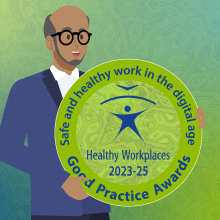From riders to nurses, cleaners and translators: explore the diverse profiles of platform workers
Digital platform work takes many forms, mirroring the diversity found across the sectors it encompasses. This article provides an overview of who are the digital platform workers and what type of jobs and tasks they carr...
HSE+ engages Italian readers on the new campaign and digital platform work
One of the newest additions to the network of media partners, HSE+ based in Italy, has recently brought attention to the 2023-25 Healthy Workplaces Campaign ‘Safe and healthy work in the digital age’ through several arti...
Prijavite se za priznanja za dobro prakso, ki vključuje delo v digitalni dobi!
Natečaj za priznanja za dobro prakso na področju zdravih delovnih mest, ki ga organiziramo v sodelovanju z našimi nacionalnimi informacijskimi točkami, je namenjen vsem vrstam organizacij po vsej Evropi, ki kažejo inovat...
Infografika med novimi viri o delu na digitalni platformi
Delo na digitalni platformi vključuje veliko različnih delovnih mest in delavcev, ki se srečujejo z zelo različnimi izzivi na področju varnosti in zdravja pri delu. Za dopolnitev obstoječih virov za ozaveščanje o tem pre...
Digital innovation in preventive healthcare: insights from International ORP Foundation's webinar
The International ORP Foundation, a new official campaign partner of the Healthy Workplaces Campaign 2023-25 'Safe and healthy work in the digital age', recently hosted a webinar titled 'Digitalisation and wellbeing: a n...
Pagination






